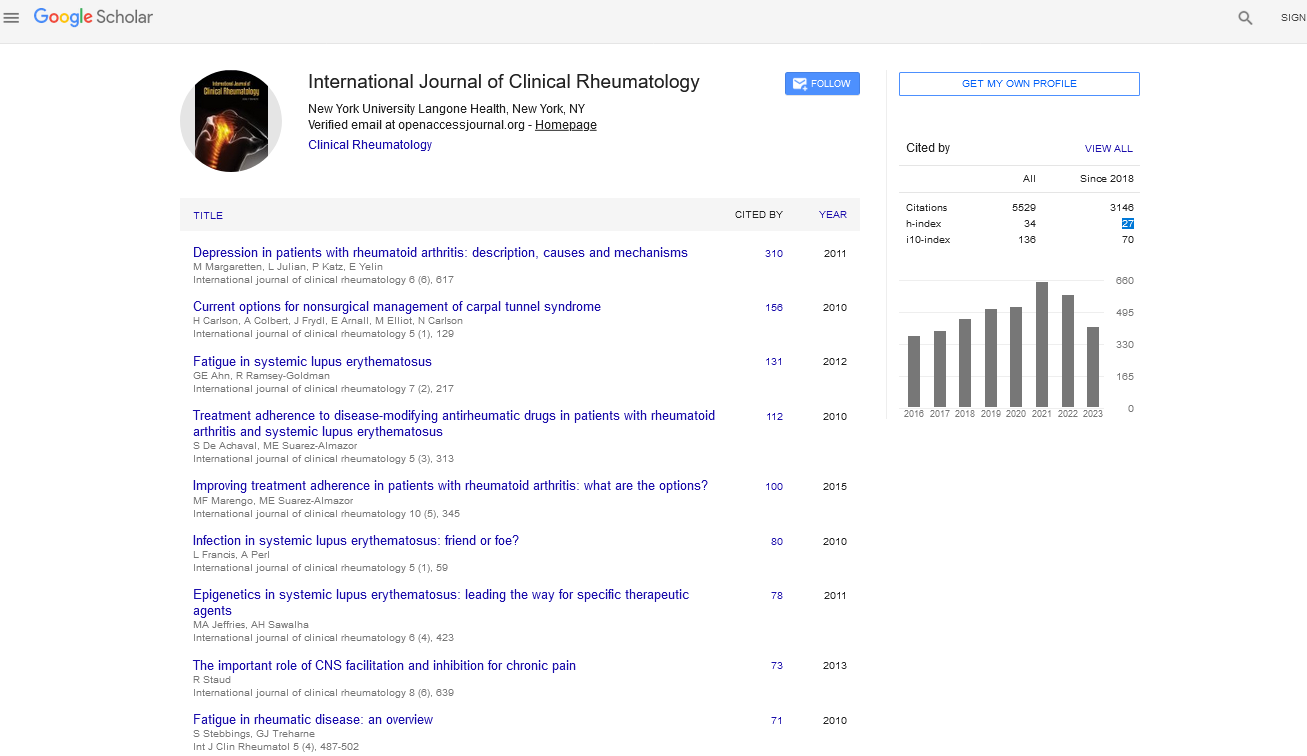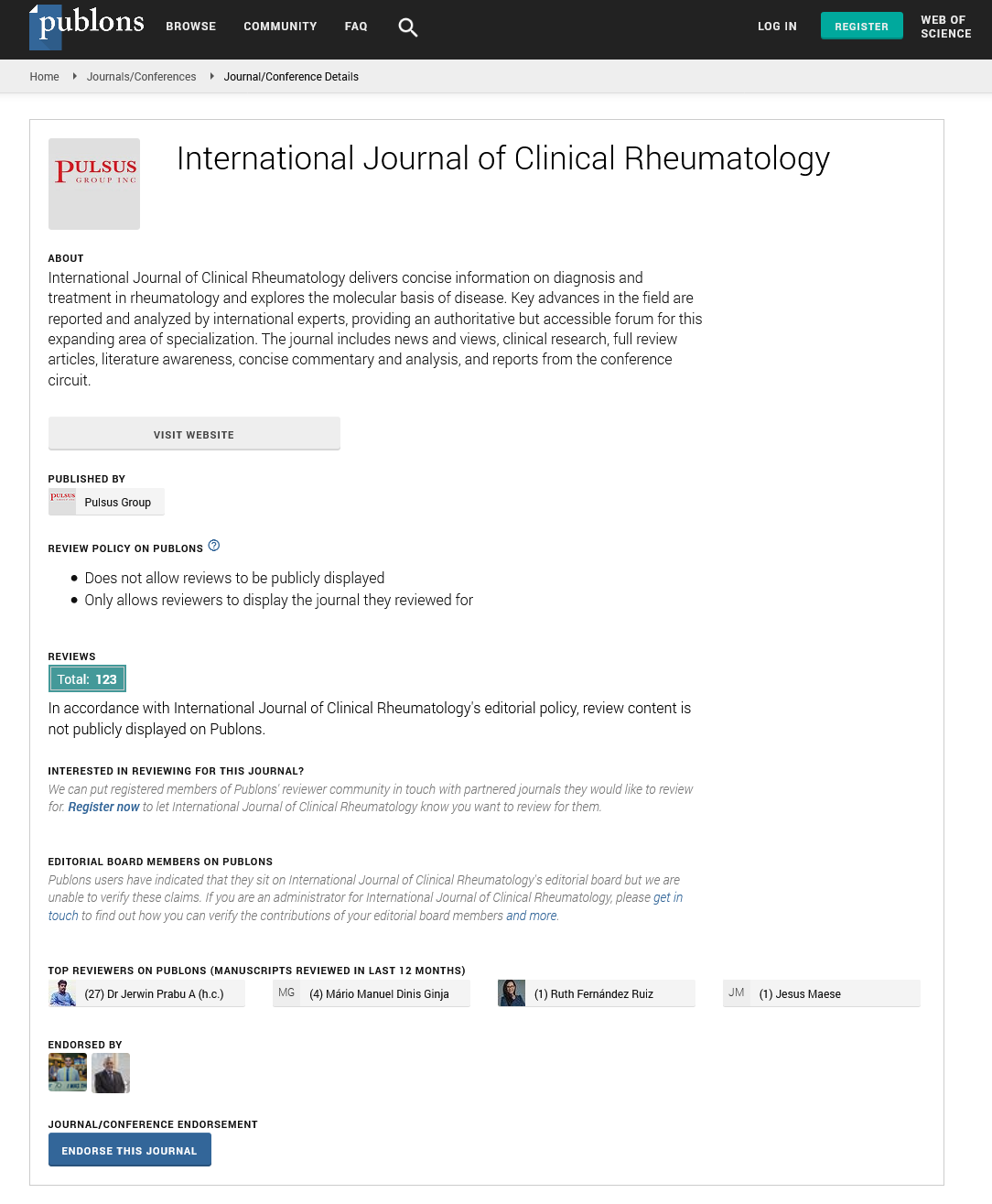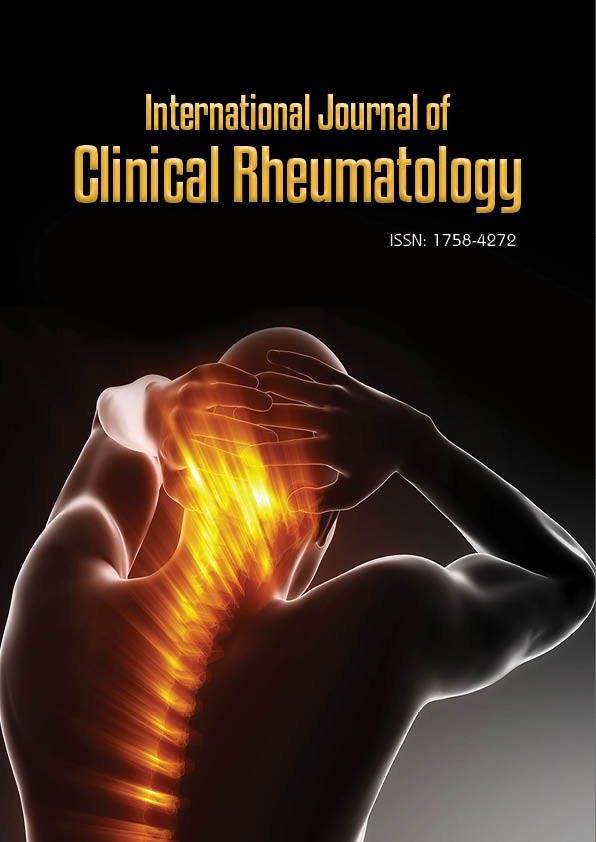Perspective - International Journal of Clinical Rheumatology (2024) Volume 19, Issue 7
Understanding Cartilage Damage: Causes, Symptoms, and Treatment Approaches
Emily Wilson*
Paediatric Rheumatology Unit, Hospital Infantile Universitario Niño Jesús, Madrid, japan
- *Corresponding Author:
- Emily Wilson
Paediatric Rheumatology Unit, Hospital Infantile Universitario Niño Jesús, Madrid, japan
E-mail: emily.wilson@gmail.com
Received: 01-Jul-2024, Manuscript No. fmijcr-24-150651; Editor assigned: 03- Jul-2024, Pre-QC No. fmijcr-24-150651 (PQ); Reviewed: 16-Jul-2024, QC No. fmijcr-24-150651; Revised: 22- Jul-2024, Manuscript No. fmijcr-24-150651 (R); Published: 29- Jul-2024, DOI: 10.37532/1758- 4272.2024.19(7).240-243
Abstract
Cartilage damage is a significant health issue that affects joint function and leads to pain and discomfort, impacting individuals' quality of life. This article examines the various causes and symptoms associated with cartilage deterioration, providing insight into both traumatic injuries and age-related degeneration. Early recognition of symptoms, including pain, swelling, and limited joint mobility, is essential for prompt diagnosis and intervention. The article details key diagnostic methods, such as advanced imaging techniques and arthroscopy, which are crucial for evaluating the extent of cartilage damage. Treatment options for cartilage damage are diverse, ranging from conservative management strategies—like physical therapy and lifestyle modifications—to more invasive surgical interventions, including joint preservation techniques and joint replacement surgery. Additionally, the article highlights emerging biological therapies that show promise for promoting cartilage repair and regeneration, offering hope for improved outcomes. Prevention is a central theme, emphasizing the importance of maintaining a healthy lifestyle, engaging in regular physical activity, and using appropriate protective gear during sports and high-impact activities to reduce the risk of cartilage damage. By providing a comprehensive overview of the complexities surrounding cartilage damage, this article aims to empower readers with the knowledge necessary for better joint health. It encourages individuals to be proactive in recognizing symptoms, seeking timely diagnoses, and exploring treatment options. Ultimately, this exploration seeks to foster a deeper understanding of cartilage health, contributing to improved awareness and management strategies that can enhance overall joint function and well-being.
Cartilage damage â Osteoarthritis
Introduction
Cartilage, a resilient connective tissue crucial for joint functionality, plays a pivotal role in ensuring smooth movement and structural support within the human body. Despite its significance, cartilage is susceptible to damage, leading to various health issues [1]. This article embarks on a comprehensive exploration of cartilage damage, shedding light on its causes, symptoms, and diverse treatment options. As an integral component of joints, cartilage serves as a protective cushion, facilitating frictionless movement and distributing forces during daily activities. However, when subjected to trauma, wear and tear, or inflammatory conditions, cartilage can undergo degeneration, resulting in a spectrum of problems that affect joint health [2]. Understanding the intricacies of cartilage damage is vital for both healthcare professionals and individuals seeking to manage and prevent associated complications. This article aims to unravel the complexities surrounding cartilage damage, offering insights into the factors contributing to its occurrence and the diverse array of symptoms that manifest when the integrity of this essential tissue is compromised [3]. Additionally, we will explore the diagnostic methods used to assess cartilage damage and delve into the spectrum of treatment options available, ranging from conservative approaches to advanced surgical interventions [5]. In essence, this exploration aims to empower readers with a deeper understanding of cartilage damage, enabling informed decision-making, proactive preventive measures, and improved management strategies for those affected by this common yet impactful health concern.
Anatomy of Cartilage
Cartilage is a firm, rubbery tissue that covers the ends of bones in joints and provides a smooth surface for movement. It is present in areas such as the knees, hips, shoulders, and spine. The three main types of cartilage are hyaline cartilage, fibrocartilage, and elastic cartilage [6]. Each type serves a specific purpose in the body, such as providing shock absorption or flexibility.
Causes of Cartilage Damage
Cartilage damage often results from trauma, such as sports injuries, falls, or automobile accidents. Direct impact on a joint can lead to tears, fractures, or dislocations, causing immediate damage to the cartilage. As individuals age, the cartilage can undergo wear and tear, leading to conditions like osteoarthritis [7]. This degenerative joint disease involves the gradual loss of cartilage, resulting in pain, stiffness, and reduced joint mobility. Genetic predisposition can also contribute to cartilage disorders. Certain individuals may have an increased risk of developing conditions like osteoarthritis due to their genetic makeup [8]. Conditions such as rheumatoid arthritis and lupus can cause inflammation in the joints, leading to cartilage damage over time. The body's immune system mistakenly attacks the cartilage, causing degradation. Continuous stress on a joint due to overuse or repetitive activities can contribute to cartilage damage. This is commonly seen in athletes or individuals with physically demanding occupations.
Symptoms of Cartilage Damage
Cartilage damage often manifests as pain and discomfort, especially during movement. The pain may be sharp or dull, and it can range from mild to severe.
Injured cartilage can trigger an inflammatory response, leading to swelling in the affected joint. This swelling can further contribute to pain and limit joint function.
Cartilage damage can result in stiffness in the affected joint, making it challenging to move. Reduced range of motion is a common symptom, especially in advanced cases.
In some cases, individuals with cartilage damage may experience a grating or popping sensation when moving the affected joint. This is often due to the irregular surfaces of damaged cartilage rubbing against each other.
Diagnostic Methods for Cartilage Damage
Medical professionals use various imaging techniques to diagnose cartilage damage, including X-rays, magnetic resonance imaging (MRI), and computed tomography (CT) scans. These methods help visualize the structure and integrity of the cartilage.
Arthroscopy: Arthroscopy is a minimally invasive surgical procedure that involves inserting a small camera into the joint. This allows for a direct visual inspection of the cartilage and other structures within the joint. Physical examinations by healthcare professionals can provide valuable information about the symptoms and functional limitations associated with cartilage damage [9].
Treatment options for cartilage damage
Mild cases of cartilage damage may be managed conservatively. This can include rest, physical therapy, and pain management strategies. Non-steroidal anti-inflammatory drugs (NSAIDs) may be prescribed to alleviate pain and reduce inflammation.
Joint preservation techniques: In cases where the damage is limited, joint preservation techniques such as microfracture or autologous chondrocyte implantation may be considered. These procedures aim to stimulate the growth of new cartilage or transplant healthy cartilage cells into the damaged area. In advanced cases of cartilage damage, joint replacement surgery may be necessary. This involves replacing the damaged joint with an artificial implant, such as in total knee or hip replacement procedures [10].
Biological therapies: Emerging biological therapies, such as platelet-rich plasma (PRP) injections and stem cell treatments, are being explored as potential options for cartilage repair. These therapies aim to harness the body's natural healing processes to promote cartilage regeneration.
Prevention of cartilage damage
Engaging in regular exercise, maintaining a healthy weight, and adopting a balanced diet can contribute to overall joint health and reduce the risk of cartilage damage. Athletes and individuals engaging in activities with a higher risk of joint injuries should use appropriate protective gear, such as knee pads or braces, to reduce the impact on joints. Whether in sports or daily activities, using proper technique and body mechanics can help prevent excessive stress on joints, reducing the risk of cartilage damage.
Regular check-ups: Regular medical check-ups can help identify and address joint issues at an early stage, preventing the progression of cartilage damage.
Conclusion
In conclusion, the exploration of cartilage damage reveals the complexity of this common health concern and the profound impact it can have on individuals' well-being. Cartilage, a linchpin in joint health, is vulnerable to a myriad of factors, ranging from traumatic injuries to age-related wear and tear. The symptoms, including pain, swelling, and reduced joint mobility, underscore the importance of early detection and intervention. Diagnostic methods, such as imaging techniques and arthroscopy, offer valuable insights into the extent of cartilage damage, enabling healthcare professionals to tailor treatment plans accordingly. The spectrum of treatment options, from conservative measures to advanced surgical interventions and emerging biological therapies, underscores the dynamic landscape of cartilage repair and regeneration. Moreover, as we delve into prevention strategies, it becomes evident that maintaining a healthy lifestyle, adopting proper techniques during physical activities, and utilizing protective gear can significantly mitigate the risk of cartilage damage.
References
- Millan M, Merino S, Caro A, Feliu F, Escuder J, et al. (2015) Treatment of colorectal cancer in the elderly. WJGO 7: 204-220.
- (2022) The Age Old Excuse: The Under Treatment of Older Cancer Patients. Macmillan Cancer Support.
- Goyal S, Chandwani S, Haffty BG, Demissie K (2014) Effect of Travel Distance and Time to Radiotherapy on Likelihood of Receiving Mastectomy. Ann Surg Oncol 22: 1095–1101.
- Susan BR, Muss BH (2006) Adjuvant chemotherapy in the elderly: Whom to treat, what regimen? Oncologist 11: 234–242.
- Hurria A (2007) Clinical trials in older adults with cancer: past and future. Oncology 21: 351–358.
- Carol A, Selby TR, Siu LL (2005) Systematic review of barriers to the recruitment of older patients with cancer onto clinical trials. J Clin Oncol 23: 3112–3124.
- Muss H, Biganzoli L, Sargent D, Aapro M (2007) Adjuvant therapy in the elderly: making the right decision. J Clin Oncol 25: 1870–1875.
- Extermann M, Aparo M (2000) Assessment of older cancer patients. Hematol Oncol Clin North Am 14: 63–77.
- Extermann M (2003) Studies of comprehensive geriatric assessment in patients with cancer.Cancer Control10: 463–468.
- Guralink JM (1996) Assessing the impact of comorbidity in the older population.Ann Epidemiol 6: 376–380.
Indexed at, Google Scholar, Crossref
Indexed at, Google Scholar, Crossref
Indexed at, Google Scholar, Crossref
Indexed at, Google Scholar, Crossref
Indexed at, Google Scholar, Crossref
Indexed at, Google Scholar, Crossref
Indexed at, Google Scholar, Crossref


